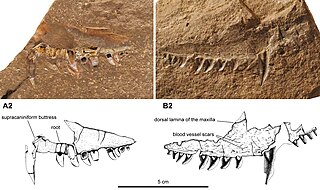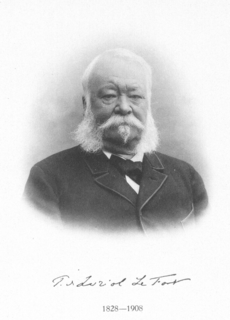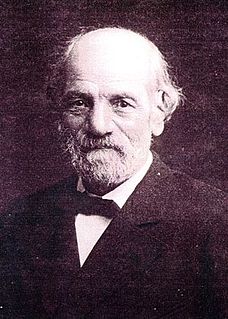Related Research Articles
Alphonse Briart (1825–1898) was supervisor of the coal mines at Bascoup and Mariemont near Morlanwelz in the Hainaut province of Belgium, and a geologist who studied that region. During the period 1863-1896 he and Francois Cornet published a number of books and papers describing fossils and geological structures found near Mons. They devised theories - now generally accepted - as to the geological history of the region. After Cornet's death in 1887, Briart continued to write alone.

Eugène Renevier Swiss geologist, was born at Lausanne, Switzerland, as a descendant of a noble family.

Neosaurus is an extinct genus of pelycosaur-grade synapsids from the Late Carboniferous-Early Permian of the Jura region of France. It is known only from a partial maxilla or upper jaw bone and an associated impression of the bone. The teardrop shape of the teeth in the jaw indicate that Neosaurus belongs to the family Sphenacodontidae, which includes the better-known Dimetrodon from the Southwestern United States. The maxilla was first attributed to an early diapsid reptile in 1857, and later a crocodylomorph in 1869, before finally being identified as a sphenacodont synapsid in 1899, a classification that still holds today.
Sclerorhynchus is an extinct genus of ganopristid sclerorhynchoid that lived during the Late Cretaceous. The genus Ganopristis is considered a junior synonym of Sclerorhynchus. It was a widespread genus, with fossils found in the Middle East, North Africa, Europe, and North America. While it had a long rostrum with large denticles similar to sawfishes and sawsharks, its closest living relatives are actually skates. Complete specimens of S. atavus show that its fin arrangement was similar to skates, with the pectoral and pelvic fins touching, both dorsal fins located behind the pelvic fins, and a reduced caudal fin.
Léon Pervinquière was a French geologist and paleontologist. He was Chef des Travaux Pratiques de Géologie at the Sorbonne in Paris. He was also seen as a geographer.
Gustave Frédéric Dollfus was a French geologist and malacologist. He was the father of parasitologist Robert-Philippe Dollfus (1887–1976).

Charles Louis Perceval de Loriol was a Swiss paleontologist and stratigraphist.

Auguste Jaccard was a Swiss geologist and paleontologist. His scientific research, for the most part, was associated with the Jura Mountains.
Philippe de La Harpe was a Swiss physician known for research in the fields of geology and paleontology.
Charles-Théophile Gaudin was a Swiss paleontologist known for his research in the field of paleobotany.
Georges de Tribolet was a Swiss geologist. He was the older brother of geologist and paleontologist, Maurice de Tribolet (1852–1929).

Aloïs Humbert was a Swiss naturalist and paleontologist who specialized in the study of myriapods. He also described new vertebrates, molluscs and flatworms.
Henri Coquand was a French geologist and paleontologist.

Gustave Honoré Cotteau was a French judge, naturalist and paleontologist.
François Cyrille Grand'Eury was a French geologist, paleontologist and mathematics teacher.

Olry Terquem was a French pharmacist and paleontologist. He was a nephew of mathematician Olry Terquem (1782–1862).

Jean Alphonse Favre was a Swiss geologist. He was a pioneer of alpine geology and became director of the Swiss Geological Commission (Schweizerische Geologische Kommission).

Philippe Thomas was a French veterinarian and amateur geologist who discovered large deposits of phosphates in Tunisia. Despite the huge economic importance of his discovery, he received little recognition during his life. Monuments to Thomas in Tunisia were destroyed after the country gained independence.
Victor-Auguste Gauthier was a French school teacher and amateur palaeontologist. He specialized in the study of fossilized sea urchins, contributing meticulous descriptions of many fossils found in southern France, Algeria, Tunisia and Persia.

Alphonse Péron was a French soldier and amateur naturalist. He used his spare time to pursue his interest in paleontology, and authored or coauthored several important works on the geology and paleontology of France and Algeria.
References
- 1 2 Dictionnaire biographique des Genevois et des Vaudois qui se sont ..., Volume 1 by Albert de Montet
- ↑ Google Books Bulletin de la Société vaudoise des sciences naturelles, Volume 11.
- ↑ GBIF.org Pseudomelania Pictet & Campiche
- ↑ GBIF.org Cryptoplocus Pictet & Campiche
- ↑ GBIF.org Archived 2015-04-28 at archive.today Pseudocassis Pictet & Campiche
- ↑ Notice sur L'Origine et L'Installation du Musée Géologique de Lausanne by E. Renevier
- ↑ Catalog HathiTrust Description des fossiles du terrain crétacé des environs de Sainte-Croix.
- ↑ Google Search Description des fossiles du terrain crétacé des environs de Sainte-Croix
- ↑ Travaux du Laboratoire de géologie de la Faculté des sciences ..., Volumes 7-8 by Université scientifique et médicale de Grenoble. Laboratoire de géologie